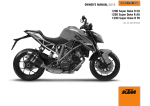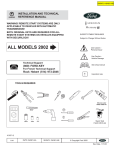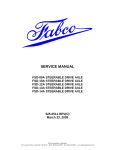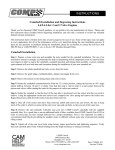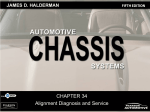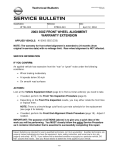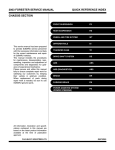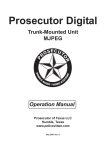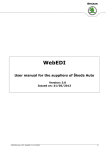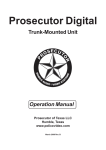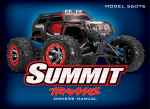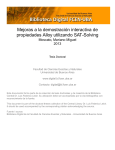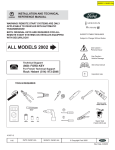Download Alignment Basics
Transcript
Specialty Products Company Basic Wheel Alignment Fundamentals Wheel alignment technology advances continuously with the introduction of new makes and models of vehicles, engines, transmissions/ transaxles, steering and electronic suspensions. Two wheel alignment is quickly becoming obsolete and four wheel alignment is rapidly being incorporated on many of the new models. With the technology being incorporated in the newer vehicles, it’s not just the front tires which steer the vehicle. Many manufacturers now use four wheel steering and complex electronic suspensions. Specific procedures must be followed to ensure proper wheel alignment. On these newer, more sophisticated vehicles, an alignment technician can easily end up misaligning the wheels by not following the proper procedures. With today’s computerized vehicle systems, improperly aligned wheels can effect engine performance, ride, tire wear, steering and premature component failure. Wheel alignment is the proper adjustment of ALL the interrelated suspension angles. In alignment terminology, these adjustment angles are called caster, camber, toe-in, steering axis inclination (SAI), vehicle ride height and toeout on turns. The method of checking wheel alignment will vary with the type of equipment being used. Although the outcome of the alignment must be the same, it is important to follow the instructions furnished by the manufacturer. On most new vehicles, only camber and toe angles are mechanically adjustable. Some technicians may encounter a vehicle that will not be able to achieve the specified angles. On these vehicles, a more thorough inspection of all the interrelated components must be done. Most of the time, replacing worn or even marginally worn parts will correct the out-of-specification vehicle. Wheel alignment should never be performed on a vehicle with worn or defective chassis/suspension components. The technician should consult with the vehicle owner on any particular problem before an attempt at wheel alignment is made. Talking with the owner first will help diagnose the problem area. A thorough visual inspection of the vehicle should then be performed. Record visual signs of tire wear and any ride height imperfections to ensure these areas are corrected prior to alignment adjustments. Test driving the vehicle as part of the diagnostic process is essential. Some vehicles may not need an alignment. Instead, the steering wheel may need to be centered or the suspension may need repaired. A test drive will be helpful in diagnosing a vehicle problem. Follow the pre-alignment procedure as a guide to ensure all areas are inspected before actual adjustments are made. Alignment Angle Terminology Caster Angle Caster is the angle between an imaginary line drawn through the upper and lower steering pivots and a line perpendicular to the road surface (viewed from side of vehicle). If the top of the line tilts rearward, the vehicle is said to have “POSITIVE” caster. If the top of the line tilts forward, the vehicle is said to have “NEGATIVE” + 0º Positive Caster Lead Point Wheel Contact Point 0º - Specialty Products Company • Toll Free Hotline 800-525-6505 Negative Caster 1 Basic Wheel Alignment Fundamentals - Continued caster. Positive caster can also be defined as when the spindle is tipped so that the pivot support centerline intersects the road surface at a point in front of the initial tire contact. Negative caster would then be the center line intersection to the road surface behind the initial tire contact. Most vehicles produced today do not have adjustable caster angle. Many early model vehicles have adjustable caster in which road crown is compensated for (along with camber). By setting the caster angle on the driver’s side 1/2 degree less than the passenger side for positive caster specifications or 1/2 degree more for negative caster specifications, the road crown should not cause vehicle pull in either direction. Vehicles equipped with manual steering use very little positive or negative caster. This helps reduce the steering effort at the steering wheel. The advantage of caster adjusted toward negative is greater maneuverability; however, direction stability on open road driving is reduced. The advantage of positive caster is the strong directional stability and the ease of returning the steering to a straight-ahead position. Caster will not cause tire wear unless extreme misadjustment or worn parts are involved. Always set caster (if adjustable) to specifications and within 1/2 degree from side to side. Keep road crown in mind and adjust as necessary if a pull is present after a proper alignment has been completed. Front Camber Angle The camber angle will affect the wear on the inner or outer edge of the tire. Camber is the inclination of the centerline of the wheel from the vertical as viewed from the front of the vehicle. Camber angle is measured in positive or negative degrees. Positive camber is the outward tilt of the top of the tire. Negative camber is the inward tilt of the tire at the top. If a tire was absolutely vertical, the degree of camber would be zero. Unlike the caster angle, camber will change with vehicle load and ride height. With the weight of the driver in the vehicle, front left camber will increase and front right camber will decrease. As rough road conditions are encountered, the downward thrust of the vehicle body will cause front camber to go negative. As the vehicle body movement returns upward, front camber will go positive. As camber oscillates, toe adjustment will also change with each movement of the control arm. A tire with positive camber can influence the vehicle with a directional pull. The vehicle will go towards the 2 side that has the tire with the most positive camber. It is the normal tendency of the tire to roll around the center - 0º + Positive Camber 0º Negative Camber of a circle when the top of the tire is inclined towards the center of that circle. Positive camber tends to place the tire-to-road contact area nearer the point of load. This assists in easier steering and forces the thicker inner portion of the spindle to carry most of the load. Modern suspension design has reduced the need for considerable positive camber. Many manufacturers specify a slight amount of negative camber. Some manufacturers recommend an additional 1/4 to 1/2 degree positive camber on the left wheel to compensate for road crown. The car will then pull toward the side with greater positive camber. This will offset the pull effect of the road crown. Always set camber within specifications. Rear Camber Angle Front Wheel Drive Rear wheel camber angle is being relied on for improved steering and general handling performance. In the past FWD vehicles and independent rear suspension vehicles were most likely to have adjustable rear camber. On vehicles currently being produced, rear camber adjustment capabilities are being found on all types of models. Note: Always use full-floating tables under wheels whenever alignment is being done. When alignment problems are reported on vehicles with fixed rear axles and no rear wheel camber adjustment capabilities, a thorough inspection of the rear suspension should be made. Damaged or worn components can cause alignment and/or steering problems. Replacing or repairing the defective components should bring the rear wheel assemblies into specification. Specialty Products Company • Toll Free Hotline 800-525-6505 Basic Wheel Alignment Fundamentals - Continued On vehicles where rear wheel camber is adjustable, all previous precautions apply. If camber adjustment requirements are excessive, a thorough inspection must be performed. Replacing any defective components could bring the camber into specification and adjustment may become unnecessary. As with the front suspension, DO NOT perform alignment on vehicles with damaged or worn components. Whether the rear suspension is adjustable or not, if all components are in good condition and the proper specifications cannot be obtained, aftermarket correction kits may be needed. Many of these kits are available from Specialty Products Company. Rear Camber Angle Rear Wheel Drive On RWD vehicles, where rear camber is usually not adjustable, camber will normally be fixed at zero. Even though this angle cannot be changed through adjustment, if rear suspension abnormalities exist, a thorough inspection must be made. Not to be overlooked are the rear springs. Worn or weak rear springs will alter riding height and because of a reduction in tension, will bring the shock absorbers out of the optimum range of their dampening ability. The result will be excessive tire movement. This condition reduces operator control and contributes to abnormal tire wear. As in FWD vehicles, replacing worn or defective components may bring rear wheels within specification. Toe-In and Toe-Out Unlike caster and camber, which are measured in degrees, toe is most frequently measured in fractional inches, millimeters or decimal degrees. The system of measurement selected will depend on the type of equipment available. An incorrect toe setting is one of the main alignment factors that cause excessive tire wear. Front and rear toe are the same in definition, with the adjustment capabilities and procedures being the only actual difference. Toe is the difference between the leading edge (or front) and trailing edge (or rear) of the tires. Toe-in is the measurement in fractions of an inch, millimeters or decimal of degrees that the tires are closer together in the front than they are in the back. Toe-out is the same measurement, except the tires are further apart in the front than in the rear. Some manufacturers measure the angular change from straight-ahead in degrees. Slight toe-in is preferred to toe-out on most vehicles because steering is aligned while the vehicle is stationary. When the vehicle Toe In Toe Out is moving, linkage components flex causing a change in alignment angles. This is classified as “Running Toe.” Running toe should be zero to maximize tire life and achieve the least rolling resistance. The usual tendency is for the tires to turn outward while the vehicle is in motion, so most vehicles are designed with a static toe-in setting. The static toe-in setting will become zero as the linkage flexes when the vehicle is in motion. Always set toe to the manufacturer’s specifications. On vehicles with toe adjustment capability on the rear, an alignment specialist can go beyond manufacturer’s specifications according to vehicle usage and customer requirements. With the proper equipment, the rear axle can be adjusted to perform aggressively toward demanding load and road conditions. Vehicles with FWD and independent rear suspensions are more likely to have adjustable rear toe. As with rear camber, properly adjusted rear toe will contribute to improved steering and handling characteristics. Full floating tables must be used under the rear tires whenever toe is to be adjusted. If rear toe is out of specification a thorough inspection must be done, whether or not rear toe is adjustable. Components found to be defective must be replaced. On vehicles that do not have rear toe adjustment capability and toe is not within specifications, replacing defective components may bring toe within specifications. If proper toe specifications cannot be obtained, alignment correction kits may have been developed since the vehicle was produced. Contact Specialty Products Company to see if any of these types of kits are available for the vehicle. Toe-Out on Turns When a vehicle enters a turn, the outer tire must travel a greater distance than the inner tire. The tire center is tangent to the turn circle. If the tires were to Specialty Products Company • Toll Free Hotline 800-525-6505 3 Basic Wheel Alignment Fundamentals - Continued remain parallel in a turn, one tire would drag across the road surface. This would create tire squeal, excessive tire wear and reduce handling performance. The outside front wheel must therefore be turned at less of an angle than that of the inside front wheel. This will keep both wheels tangent to their respective turning circles and prevent tire squeal and/or damage. As the vehicle enters a turn, the tie rod ends will travel an equal distance, but due to the angle of the steering arms the tires will progressively toe-out. Toe-Out on Turns (Also referred to as: Turning Angle or Turning Radius) Although this angle is never adjustable, it is easily checked on the alignment rack by turning the tires 20 degrees on full floating tables. First turn the front right tire 20 degrees and read the indicator on the left wheel. This is the angle of toe-out for the left tire. Repeat the procedure for the remaining side. Compare reading with specifications. Readings not within specifications are an indication that the steering arms are bent and should be replaced. Never bend or heat components to repair them. Steering Axis Inclination (SAI) Steering Axis Inclination (SAI) can be a difficult angle to understand. SAI is also referred to as the ball joint angle or kingpin inclination (on I-Beam suspension). The easiest way to understand SAI is to first define steering axis. The steering axis is an imaginary line intersecting the spindle support. In a conventional steering system, the spindle supports are the upper and lower ball joints or the kingpins. With MacPherson strut systems, steering axis is the angle beginning at the ball joint and extended through the strut assembly. Viewed from the front of the vehicle, SAI is the angle between the steering axis and a true vertical line established through the tire. The SAI is a stability angle and is measured in degrees. If these imaginary lines were extended to the road surface, the area cov- 4 ered between them would be identified as the point of load or scrub radius. S.A.I. The vehicle body will be closest to the road surI.A. face when the wheels are pointed straight-ahead as a result of SAI. A spindle with SAI will have the outer end of that spindle at the highest point when the wheels are pointed straight-ahead. Therefore, as the weight of the vehicle pushes downward, the spindle will always attempt to move upward to return the wheels to a straight-ahead position. After a turn, the SAI helps to return the tires to straight-ahead position. SAI also aids in vehicle directional stability by resisting road irregularities that attempt to turn the wheels away from the straight-ahead position. SAI produces many of the same benefits that improve steering stability as positive caster. Correct engineering of SAI can reduce the need for high positive camber. The effect of SAI on directional stability is usually greater then that of caster. Some vehicles with power steering require a greater amount of steering wheel returning force than those with manual steering. SAI is often used with positive caster on power steering equipped vehicles to assist in steering wheel returnability. Camber Scrub Radius Scrub radius is the term used to describe the distance between the projected steering axis and the tread centerline at the road surface. Scrub radius is positive when the centerline of the tire lies outside the projected steering axis. It is negative when the centerline of the tire is inside the projected steering axis. The scrub radius is a distance measurement and it is therefore measured in inches or millimeters. The size of the scrub radius depends on the steering axis inclination, wheel offset and the distance the spindle centerline is above the road surface. By carefully considering the correct SAI and the proper wheel offset for the designed spindle height, the required amount of scrub radius is designed into the suspension. Although the spindle height has an effect on the scrub radius, little can be done to change this height Specialty Products Company • Toll Free Hotline 800-525-6505 Basic Wheel Alignment Fundamentals - Continued because tire height is limited by the clearance space under the fender and body. Since all handling sensations pass between the tire and the road, the scrub radius provides the necessary feedback to give the driver road feel. Setback Setback or front end squareness is a condition in which one wheel is rearward of the other. If setback is present the turning radius will not be correct when the vehicle turns. With this condition, the tires will wear very much in the same manner as if they were under inflated. Generally, setback is the result of collision damage. It is preferable to have the front tires square with each other before alignment is done. Considering the many different types of alignment equipment available, it is not possible to cover each checking procedure. Use the alignment machine manufacturer’s instructions for checking setback. The most accurate way of checking is with four wheel alignment equipment. Depending on the severity of setback and the type of alignment equipment being used, false readings can mislead a technician into thinking that an incorrect adjustment is within specification. These false readings are experienced more frequently with two wheel alignment methods. Thrust Angle Thrust angle is the line that divides the total angle of the rear wheels. The rear tires are not just following the front tires, they are actually establishing direction of the vehicle. In doing so, a direction of thrust is developed. The thrust angle created by the rear wheels is used as a reference for aligning the front wheels. Ideally, the thrust angle should be identical to the geometric centerline of the vehicle. If thrust angle and geometric centerline are identical, the position of the tires would then form an absolute rectangle and the front tires could be aligned to the rear tires, resulting in a perfectly centered steering wheel. Because of unitized construction, factory tolerances and a varying degree of damage and/or wear, it is increasingly unlikely that the axles will be parallel. When the rear axle projects a different angle than the front axle, the driver will need to turn the steering wheel to compensate in order to drive in a straight line. On situations where the thrust line and geometric Positive Thrust Angle Negative Thrust Angle centerline are not identical, a thorough inspection of the rear axle and suspension system must be done. Replacing defective components should aid in positioning thrust angle close to the geometric centerline. If the thrust angle is not identical to the geometric centerline and there are no defective components, align the vehicle using the thrust angle instead of the geometric centerline. Aligning the front wheels to the thrust angle is preferred to aligning to the geometric centerline. The ability to do this is a significant advantage of four wheel alignment. The result should be a straight steering wheel as the vehicle moves straight-ahead. Pre-Alignment Procedures Tire Inspection Inspection of the tires can help in diagnosing some wheel alignment failures. The tire wear pattern will record improper alignment of camber or toe settings. Some wear patterns associated with improper alignment include single shoulder wear, cupping and feather edging. Some tire defects are not visually noticeable, but can affect wheel alignment. Check each wheel and tire for radial runout. Proper tire pressure is essential for properly aligning wheels. The correct pressure not only allows tires to perform at the standard for which they were designed, but is directly related to ride height. Remember that cold tires will register a slightly lower pressure than tires that are warm for usage. Tires with low pressure Specialty Products Company • Toll Free Hotline 800-525-6505 5 Basic Wheel Alignment Fundamentals - Continued will wear both outer edges. Over inflation will wear the center of the tires. Tire size and make, if different can cause a vehicle with accurate wheel alignment to have a directional pull or non-centered steering wheel. If tire sizes match, but brands and tread design differ, measure each tire individually. There is no manufacturer standard that dictates what the dimension of a given tire size will actually be. Ride Height Alignment geometry angles are established from the ride height. An improper ride height will affect the alignment geometry angles. Ride height can be affected by several different components. Improper tire size, pressure, or springs (sagged, weakened or broken), will reduce ride height and cause the geometry angles to be out of specification. If enough adjustment is remaining, the alignment angles may be brought within specifications. This may, however, produce a substandard wheel alignment. With the increase of weight and vehicle motion the original problem will reappear with the possibility of additional repair requirements. Several different areas should be measured to ensure vehicle ride height is at the factory specifications. Front Component Inspection If weak or defective components are undetected and an alignment is done, premature wear and damage can occur on other components. It is therefore essential that all components are thoroughly inspected. Adjust or replace weak or defective components before checking or making the alignment adjustments. Check control arms, stabilizer bar, strut rods and steering linkage for damage, wear indication or bent components. Look closely at bushings for signs of deterioration and improper positioning. Replace bushings as necessary. Check, measure and service ball joints, referring to a ball joint inspection service manual as necessary. Check tie rod ends for excessive up and down movement by squeezing the ends. Very little or no up and down movement should be present. Check idler arm and pitman arm for excessive play. Idler arm or pitman arm movement, other that normal turning movement should not be present. Replace components as necessary. Check wheel bearing play and service bearings as 6 necessary. Check shock absorbers for leakage and weakness. Inadequate shock absorbers will not only affect ridability, handling and alignment, they will also cause premature failure of suspension components. Rear Component Inspection It is important to understand that unrepaired, weak and/or damaged components will add to the total collective tolerance of the steering/suspension system. This total tolerance will continuously allow alignment angles to change during vehicle operation. To maintain a quality alignment, replace all components which are not within specifications. Although some vehicles do not have adjustable rear suspensions, the rear wheel position is vital to a properly aligned vehicle. With four wheel alignment equipment available, the rear wheels can be checked in proportion to the front wheels or vice versa. Many rear wheel specifications are available even on vehicles without adjustable rear wheels. If a visual inspection shows no abnormal or defective components, checking rear wheel alignment specifications (if available) will assure there are no hidden rear wheel components that are damaged or worn. If the rear wheels are not within alignment specifications, the technician should begin a thorough check of the rear suspension system. Although the rear wheels are not adjustable, components can be replaced. Replacing components, which are bent or worn, should bring the rear wheels into specifications. With the rear wheels within specifications, a more accurate front wheel alignment can be accomplished. If rear suspension is incorrect prior to alignment, the steering wheel and front wheel geometry will be off center. Tire Wear Diagnosis Because of the rigorous routine the front suspension must endure, the front tires have to work much harder than the rear tires. Even when the suspension is in good condition and the alignment is set correctly, the front tires will wear faster than the rear tires in most cases. This is the reason for tire rotation at regular intervals. When an abnormal condition develops in the suspension system, it will usually affect the tires and ride. When this happens, one or even both tires can be affected and begin a wear pattern characteristic of the problem. Specialty Products Company • Toll Free Hotline 800-525-6505 Basic Wheel Alignment Fundamentals - Continued If a vehicle has a suspension malfunction, the wear pattern of the tire should readily show what the problem is. Typically where multiple malfunctions have existed for many miles, attempting to get an accurate diagnosis can be difficult or impossible. Tire Smooth On One Side When a tire is wearing smooth on one side, it can safely be assumed that the worn area is where road contact is being made. In this case, not only is the tire wear being significantly accelerated, but control of the vehicle and handling performance are reduced. The major cause of this tire wear pattern is camber misadjustment. Incorrect camber adjustment can result from worn chassis parts, (springs, steering linkage, bushings, ball joints, etc.) or previous misalignment. Excessive positive camber will wear the outside edge of the tire and excessive negative camber will wear the inside edge of the tire. Sometimes, incorrect toe adjustment will cause shoulder wear on one side (outside wear for toe-in and inside wear for toe-out). To correct the condition, alignment and tire rotation or replacement is necessary. Feather Edging Feather edging will normally occur if the toe adjustment is incorrect. Misadjustment of toe can develop from defective chassis parts, incorrect turning radius or misalignment. Defective chassis parts are not the direct cause of feather edging but will allow toe to go out of adjustment resulting in a wear pattern. Any change in the suspension height of a vehicle will change toe measurement. Feather edging is identified by sliding the hand across the tire tread surface. Depending to which extreme the toe is misadjusted (in or out), sharp edges will be felt in one direction and smoothness will be felt in the opposite direction. Feather edging can result in a direction pull and eventually ruin the tires. To correct the condition, alignment and tire rotation or replacement is necessary. Cupping Appearance Tires will begin to develop a “cupping” appearance when the vehicle suspension loses its ability to absorb “jounce travel.” “Jounce travel” is the upward movement of the tire in relation to the vehicle’s downward movement. This condition most commonly occurs with weak shock absorbers or incorrect shock application. Other factors that should be considered when tires “cup” are the springs, tire balance and wheel alignment (in this order). As the springs sag, the shock absorber shaft will be lowered out of its effective range. When a vehicle has ineffective shocks and soft sagging springs, the vehicle becomes susceptible to excessive bouncing. The downward motion of the bounce will have a “digging” effect on the tire that produces the low spot of the cup. As this condition progresses, it will become self-perpetuating to the point that part replacement and/or tire rotation will not reverse the damage. When encountered, defective parts must be replaced and the tires rotated to the rear or replaced. When a tire begins to develop bald spots, the most common cause is an unbalanced or defective tire. Occasionally, failure to rotate tires at regular intervals can contribute to bald spots. In either case, the suspension system should be inspected. If defective components are found in the suspension system, consideration should be given as to whether or not the defective components could have caused the bald spots. If the wear pattern is not severe, balance and rotation of tires is recommended. In severe cases the tire should be replaced. Always check the alignment and adjust as necessary. This condition usually develops through abuse and poor maintenance. When tires are repeatedly under or over inflated the continuous stress can result in cracks related to fatigue at the tread. Other possibilities are excessive exposure to high temperature roads, high speed driving, or carrying loads that exceed the rated load capacity. In severe Specialty Products Company • Toll Free Hotline 800-525-6505 7 Basic Wheel Alignment Fundamentals - Continued cases, strong consideration should be given as to whether the tire should be replaced with a tire better suited to the vehicle’s operating requirements. In less severe cases, the best tires should be rotated to the front axle. Always check the alignment and adjust as necessary. Shoulder Wear (Both Sides) When a tire is under inflated, the sidewall and contact surface will be forced to fluctuate excessively. Initially, the contact surface will buckle and the tire will travel on the edges. The immediate result is shoulder wear because the outer treads are receiving all road contact. The amount of under inflation will determine the amount and severity of the tire wear. Consideration should also be given as to whether the tire should be dismounted for inner sidewall damage inspection. This can result from excessive heat buildup due to the added load displacement stress on the sidewalls. Check tires for slow leakage and repair as necessary. Center Wear If a tire shows signs of accelerated wear in the center of the tire tread, it has most likely been over inflated. Excessive pressure causes the tire to bulge in the center and will usually provide a noticeably stiff or hard ride. The added rigidity causes stress to the chassis and tire belts. This symptom is easily identified because it is uncharacteristic of other abnormal wear conditions with one possible exception. If tires are at specified pressure and questioning of vehicle operator provides no clues, check wheel rim width in relation to the size of the tires. If the tires are too wide for the rim, center wear can be a result. If the tire wear is severe, tire and/or rim replacement is recommended. In cases of minimal wear, a slight reduction of tire pressure may solve the problem. Alignment Troubleshooting 8 Condition Possible Cause Camber Not Adjustable Control arm bent. Frame bent. Hub and bearings not properly seated. Sagging springs. Front End Shimmy Excessive wheel/rim runout. Power steering reaction bracket loose. Steering gear box (rack) mount loose. Steering gear adjustment loose. Tires out of balance. Tires out of round. Wheel bearings worn or loose. Worn steering/suspension components. Hard Steering Ball joint tight or seized. Bent steering knuckle or supports. Damaged suspension components. Front tire pressure low. Idler arm bushing too tight. Power steering fluid low or belt loose. Power steering pump defective. Steering gear out of adjustment. Continued.... Specialty Products Company • Toll Free Hotline 800-525-6505 Basic Wheel Alignment Fundamentals - Continued Alignment Troubleshooting - Continued Condition Possible Cause Premature Tire Wear Bent wheel/rim. Improper torsion bar adjustment. Incorrect tire inflation. Incorrect wheel alignment. Suspension/steering system worn. Tires out of balance. Uneven or sagging springs. Worn or defective shocks/struts. Pulls To One Side Brakes dragging. Broken or sagging springs. Broken torsion bar. Control arm bushing worn. Frame bent. Idler arm bushing too tight. Incorrect wheel alignment. Incorrect tire inflation. Mismatched tires. Power steering valve not centered. Uneven sway bar links. Toe-In Not Adjustable Lower control arm bent. Frame bent. Worn or stripped tie rod end sleeves. Wheel bearings worn or loose. Vehicle Wandering Broken spring. Defective shock/strut. Incorrect tire inflation. Improper vehicle height. Incorrect wheel alignment. Rack & Pinion or steering not positioned correctly. Stabilizer bar missing or defective. Worn steering components. Worn strut rod or control arm bushings. Worn suspension components. Specialty Products Company • Toll Free Hotline 800-525-6505 9 Basic Wheel Alignment Fundamentals - Continued Bump Steer or Orbit Steer Problems Problem Bump steer or Orbit steer will occur when the steering system is out of level. Sometimes you will see one tire on one side of the vehicle wear evenly and the tire on the opposite side wear unevenly. This can occur even after the vehicle has been aligned. Most of the time the alignment will be within specifications and the tire will still wear improperly. Memory Steer on 4 x 4 and 4 x 2 Pickups Problem Memory Steer is sometimes encountered after the installation of an offset upper adjustment bushing or sleeve while making alignment adjustments. This can affect the way the vehicle will react after turning. After turning the vehicle left to right a binding can occur in the steering and will not allow the vehicle to return to center. The types of vehicles that have this problem are usually pickups that have a large amount of adjustment made from O (zero) degree sleeves or bushing installed by the manufacturer. Ford Truck Toe Changing Problem If you are having trouble getting the toe set correctly on most Ford trucks, some of the problem could be that the toe is changing while the technician tries to tighten the tie-rod sleeves. Often the tie rod stud will rotate and will cause the toe to change. 10 Solution When the vehicle is setting on the turntables with the lock pins in the table push the bumper up and down and you will see the steering wheel rotate side to side. This is a sure sign that something is out of level. Using your alignment equipment pull down on the center of the vehicle 2” to 3” and read toe and camber change. Then bring the vehicle back to level and lift up the body 2” to 3” and read toe and camber changes. If the toe is changing as much as 1/8” from side to side the Idler Arm and/or Rack is out of level and must be moved up or down to correct this problem. This will also cause the vehicle to drive poorly. Solution To correct this problem loosen the ball joint stud nut. Then break the ball joint taper between the spindle and joint. Now with the vehicle on the turntables retighten the ball joint nut starting with the lowest one first. Torque lower nut to 55 lbs., and then torque top ball joint nut to 100 lbs. To eliminate wasted time on road tests remove the tie rod end from the spindle and place a pull scale on the steering arm while pulling on the scale. This should not require more than 25 lbs. of pressure to rotate the spindle in and out. If the spindle proves to be free then reinstall tie rod end and road test the vehicle. Solution When you drive the truck on the alignment rack after inspecting the vehicle and before making any changes MARK THE TIE ROD OUTER AND THE INNER DRAG LINK with chalk. Then proceed with the alignment making the camber and caster adjustment as needed. Now you are ready to adjust toe to specification. MAKE SURE THE MARKED AREAS CONTINUE TO LINE UP. Then tighten the bolts on the sleeve. This will help you keep the correct toe setting on these vehicles. Specialty Products Company • Toll Free Hotline 800-525-6505 Basic Wheel Alignment Fundamentals - Continued Ford Pickup Vibration After Hitting Bumps Problem If you have a problem with Ford trucks vibrating severely after hitting bumps you may find that the inner pivot bushings are weak and letting the vehicle shake after you hit a bump in the road. This truck can shake so badly that the brakes will need to be applied to stop the vibration. Ford Pickups Pull Before and After Alignment Problem After doing an alignment on Ford trucks or Explorers the vehicle still pulls to one side. This can happen even if the alignment is done correctly. Steering Noise on Ford Town Cars/ Crown Victorias/ Grand Marquis Problem Solution Change the inner pivot bushings. You do not need to remove the axle to change the inner pivot bushings. Remove the axle bushing bolt. Lower the axle, press out the old bushing and install the new pivot bushings. Solution First switch the front tires side-to-side to check direction of pull. If vehicle still pulls in same direction check the steering gear box. To do this remove the pitman arm from the steering gear box. Have someone start the engine while you watch the output shaft of the gear box to check if there is any movement from the front of the output shaft. If there is, the center valve could be off-center which would allow more pressure to be applied to the side where the pull is occurring. You can also check out this problem using pressure gauges. To solve, remove the steering gear box and replace or rebuild. Solution The fix for this problem is to install a revised power steering reservoir and cap assembly (Ford Part Number F3AZ-3E764-A). This will allow you to reduce cavitation. When filling make sure to bleed the system of air before you let the car leave your shop. (Flat rate time is .5 hour just for bleeding the system.) A growling noise can come from the power steering pump on these vehicles during sharp turns. Specialty Products Company • Toll Free Hotline 800-525-6505 11












